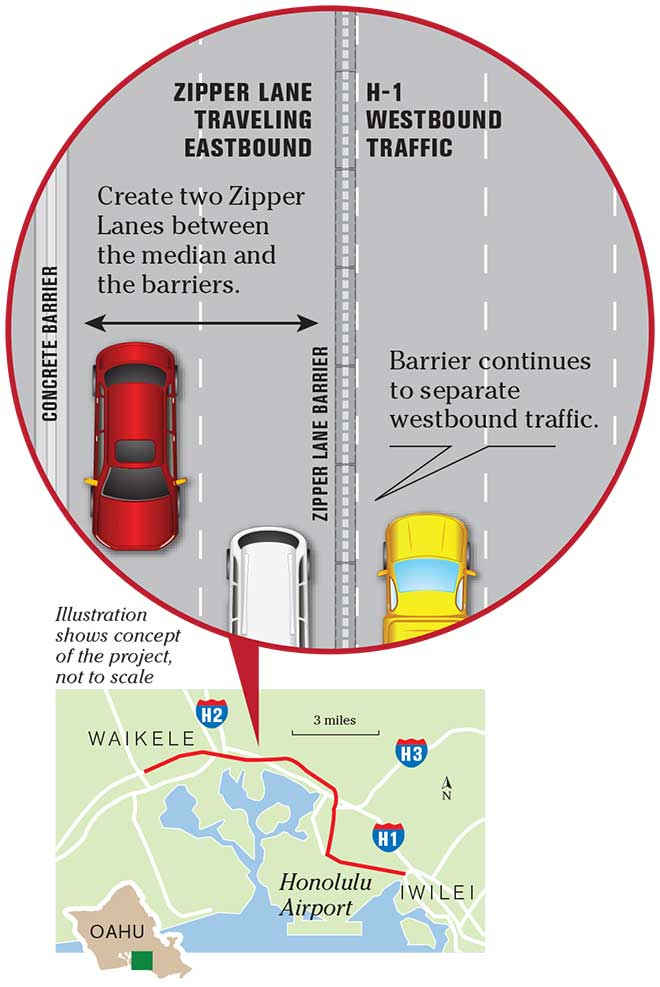H-1 Zipper Lane users will soon have two lanes to get into town instead of one — a move that state transportation officials hope will help to slightly ease the traffic congestion endured by thousands of West and Central Oahu commuters on weekday mornings.
Starting sometime in August before the school year begins, the state Department of Transportation plans to widen the Zipper Lane area so that it’s big enough to fit two lanes of traffic.
Each hour, the extra morning eastbound lane could handle as many as 1,700 of the high-occupancy vehicles, motorcycles and electric vehicles permitted to use the Zipper service, according to Ed Sniffen, DOT Highways Division deputy director.
ZIPPER LANE RECONFIGURATION
By widening the space created with the Zipper Lane’s barriers by another 2-1/2 feet, state transportation officials say they’ll create a second lane to accommodate more vehicles during the morning commute.
>> The state Department of Transportation aims to add the second Zipper Lane sometime in August before the new school year starts.
>> The added lane will be able to accommodate as many as 1,700 additional vehicles per hour, the DOT says.
>> The new configuration won’t take away lanes from westbound drivers, it says.
The DOT will also extend the Zipper’s service to 9 a.m., agency officials said. The morning commuter lane, which runs from Waipahu to Kalihi, currently is open from 5:30 to 8:30 a.m.
Sniffen said the changes represent simpler steps his agency can take to curb congestion in a city that routinely ranks among the nation’s worst for traffic — even as the DOT works on more expensive, long-term projects to widen some stretches of H-1 and boost its capacity.
“In general, the strategy right now is to look at things that we can do now, at lower cost, and that can be implemented very quickly,” Sniffen said Wednesday as a public town hall on traffic wrapped up at Kapolei Hale. “We want to do something sooner rather than later and share with you some relief. This is one of the things we do.”
In the long run, Oahu faces “tremendous” problems handling traffic as the population grows and more development emerges, he added.
Drivers heading westbound on H-1 won’t lose any lanes when the eastbound Zipper Lane service widens later this summer, according to DOT spokesman Tim Sakahara.
The widening will simply take up the rest of a lane that’s already closed off to westbound drivers during Zipper Lane service, Sakahara said. Currently, that lane gets partially blocked when the concrete barriers are deployed, he said.
It’s the first time that the Zipper will expand to include two lanes since the service launched in 1998 to help combat the island’s growing congestion, officials said. The widening requires no change to the ZipMobile machinery, according to Sniffen. He added that he didn’t know why DOT didn’t enact a widening in years prior.
The biggest challenge to the project will be to re-stripe lanes so that “everything still makes sense” whether the Zipper Lanes are opened or closed, Sniffen said. That effort should start soon, he added, although he didn’t provide a date.
Adding a second lane should also help prevent the traffic from jamming as it typically does now in the Zipper Lane when more vehicles merge into it, DOT officials said. The agency also plans to trim the Zipper to a single lane approaching the Airport Viaduct to help prevent a bottleneck toward the end of the route, as it nears the morning contra-flow lane on Nimitz Highway.
Thousands of Oahu drivers rely on the Zipper Lane to keep a bad commute from getting worse. However, when the ZipMobiles that deploy the concrete barriers break down, the situation occasionally causes traffic nightmares for those trying to get across Oahu’s South Shore. During one of the more recent incidents, the March 31, 2015, “carmageddon,” drivers reported spending five hours or more stuck in ZipMobile-related traffic.
In the longer term, the state’s DOT hopes to eventually widen stretches of the eastbound part of H-1, similar to a yearslong project completed last fall to widen the freeway westbound along the Pearl City viaduct. The eastbound project could take about seven years to design and build — plus about $120 million that “we just don’t have” now, Sniffen said.
(The agency is working to spend down some $548 million in backlogged funds that Sniffen said are fully obligated to other projects.)
Ultimately, however, the island can’t keep expanding H-1 to solve its traffic woes, Sniffen said. Instead, he said, Oahu will have to employ better land use in which its communities don’t rely so heavily on commutes across the island.
“In general, if we keep the same model we have right now, we’ll never catch up,” he said Wednesday. “Because we can talk about double-deckering H-1 and adding another 12 lanes, but $7 billion dollars later we’re going to have the same problem because development will keep up with the capacities.”



